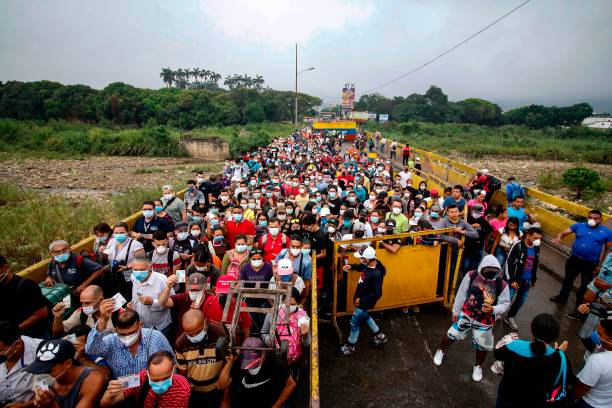When we think about massive migrations and humanitarian crises in the last five to ten years, we probably first picture the migrant waves caused by the conflict in Syria that started in 2011. After 10 years of civil war, 6.6 million people have been forced out of that country, and, according to the UN Refugee Agency (UNHCR), 6.7 million more remain internally displaced. More than 90% of Syrian migrants have found refuge in the neighboring countries of Egypt, Turkey, Lebanon, Jordan, and Iraq. Migrants also flee to European countries like Greece, Germany, and Sweden. This unfortunate and sad episode of human suffering might eclipse the second largest migratory movement and humanitarian crisis of recent years: the Venezuelan diaspora.
Venezuela was a country with nearly 30 million inhabitants in 2015, and also one of the five top oil exporters at that time – boasting the largest oil reserves in the world. Under the Hugo Chavez regime that began in 1999, a collapsing economy sealed its so-far unstoppable fate, and with it came the crumbling down of all essential public services, including health care and education, infrastructure, and the most basic-needs provisions. According to the UNHCR, there are 5.4 million Venezuelan migrants and refugees worldwide, representing nearly 20% of its 2015 population. These migrants have been fleeing rampant crime, colossal corruption, repression and persecution, lack of food and basic services, and a generalized societal breakdown, hoping to find a future elsewhere.

People coming from Venezuela with protective face masks as a precautionary measure to avoid contracting the new coronavirus, COVID-19, show hold their documents on the border at Simon Bolivar International Bridge, in Cucuta, Colombia, on March 12, 2020. – Colombia declared on March 12, 2020 a “Health Emergency” due to the new coronavirus pandemic, a figure that allows it to take exceptional measures such as prohibiting the disembarkation of cruise ships and the holding of public events with more than 500 attendees. (Photo by Schneyder MENDOZA / AFP) (Photo by SCHNEYDER MENDOZA/AFP via Getty Images)
Given their limited economic resources and scarce access to secure transportation, a substantial portion of the migration occurs via unsafe means, involving human trafficking activities or on-foot travel. The biggest receptor of Venezuelan migrants by way of these risky means is Colombia, followed by Ecuador and Perú. These three countries have absorbed more than 60% of Venezuelan migrants and refugees. Entire families with small children, pregnant women, and even handicapped people, walk for days to reach another destiny in South America. Other countries, like Mexico, Chile, Spain, Argentina, and the U.S. have experienced a considerable increase in Venezuelan migration numbers. According to Efecto Cocuyo, a Venezuelan independent digital media outlet, the changes from 2019 to 2020 in the percent of the Venezuelan migrant population are : +45% in Mexico, +37% in Spain, +29% in Paraguay, and +17% in Ecuador. According to official sources from the Ministry of Foreign Affairs in Colombia, there was an increase of 49% in the migrant population from January 2019 to January 2020.
Border closures in most Latin American countries, as a consequence of the COVID-19 containment policies, represented an even bigger pressure factor on many Venezuelan migrants and refugees, many of whom were already living under precarious conditions, with informal street jobs and near homelessness. Losses of employment and opportunities forced many of them to return to Venezuela. In February 2020, out of the 1,825,687 Venezuelans recorded as living in Colombia, about 110,000 had gone back to Venezuela by September 2020, representing a total of 3% of the 2019 refugee population. According to data from the R4V platform (UNHCR), the Venezuelan migrant return seen in Brazil and Panama was 1% during the same period.
The response to the COVID-19 pandemic contributed to an increase in food insecurity worldwide. The Latin America & Caribbean region was one of the most affected. In 2019, an estimated 4,3 million people were experiencing food insecurity conditions, and this increased to 17,1 million by August of 2020. According to RV4 (UNHCR), Venezuelan migrants and refugees are the region’s most affected group in terms of food insecurity – with about 1,3 million affected by food insecurity in Colombia, 600,000 in Perú, and 300,000 in Ecuador. The first of these figures makes up 73% of the Venezuelan migrants and refugees in Colombia, as of August 2020 (compared to 53% in April of 2020).
According to the RV4 platform, by May 05, 2021, there were 5,643,665 Venezuelan migrants and refugees globally. Of this total, 2,648,603 people have been granted a residency permit and regularized living conditions inside receptor countries around the world, with Colombia, Chile, and Perú hosting the largest percentages in this category. There are 850,818 Venezuelans with pending refugee requests, with Perú, the U.S., and Brazil hosting the largest percentages. There are also 171,793 officially recognized Venezuelan refugees, with the largest percentages coming from receptors Spain, Brazil, and the U.S.
What are the projections for the end of the year 2021? How will these trends evolve across the different receptor countries? There are many factors playing a role in addressing these questions objectively. If the internal political, economic, and social situation in Venezuela does not improve, the migratory movement is expected to steadily continue its rising course. The responses to the COVID-19 pandemic caused a temporary disruption to the process, but the flow will continue as country borders reopen and many of the receptor countries implement mechanisms to try and regularize the Venezuelan migrant and refugee situation. Coming up with accurate projections of this multi-directional human flow is a challenging task, especially for international agencies and bodies like the regional R4V (UNHCR) and the Migrations International Office that must try to plan for the amount of aid requested to assist and support the needs of the most vulnerable groups.
In closing, one country’s problem is not an isolated problem affecting solely the population of that country. It is a crisis that percolates into all possible pathways and results in a domino effect impacting many other nations. Future projections are challenging in an interconnected world. There are many public policy actions that need to be taken within the receptor countries to avoid internal conflicts arising from the extra burden of coping with the influx of a vulnerable population. These population influxes exacerbate the fragile internal social conditions already existing in most of these countries. A crisis of this magnitude requires a common and unified effort from different organizations, specially in the South American continent. The role of statisticians to procure realistic estimates in the migration flows might make a considerable difference in quantifying real needs for the most vulnerable population and would support preparedness actions at each of the receptor countries. Ideally, the optimal solution would be to remove the initial cause of the problem – a real cause-and-effect example. But this is a discussion topic for a different venue…





